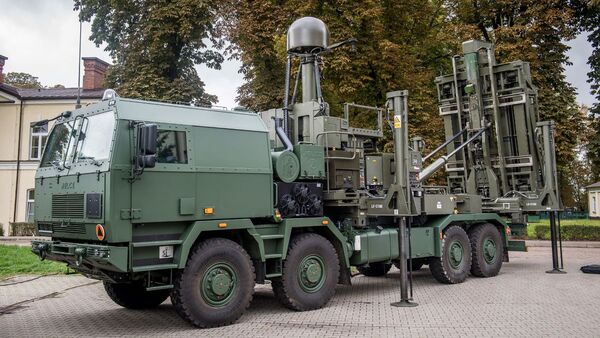- About
- Intara
- Capabilities
- Advisory
- Resources
- News
- Store
Poland orders iLaunchers and CAMM missiles
02 May 2023
by Nicholas Fiorenza


The Polish Armament Agency and MBDA have signed a contract for 44 iLaunchers and hundreds of CAMMs for Poland's Pilica+ air-defence upgrade programme. (Polish Armament Agency)
The Polish Armament Agency (AA) and MBDA have announced that they have signed a contract for 44 iLaunchers and hundreds of Common Anti-Air Modular Missiles (CAMMs) for Poland's Pilica+ air-defence upgrade programme. MBDA said in a press release on 27 April that the GBP1.9 billion (USD2.37 billion) contract to modernise and manufacture iLaunchers and CAMMs for 22 Pilica+ batteries made it the largest European short-range air defence (SHORAD) acquisition in NATO. Deliveries are scheduled for 2025–29, the AA said in a 28 April press release.
Designed by Polish Armaments Group (Polska Grupa Zbrojeniowa: PGZ), Pilica+ will combine CAMM short-range radar-guided missiles with Polish-made autocannon and very-short range infrared-guided missiles into a triple-layer system commanded by a Polish command-and-control system and guided by Polish radars, according to MBDA. Pilica+ will form the inner tier of the integrated Polish air-defence system, defending high-value and mobile assets, with CAMMs providing the capability to defeat air threats out to 25 km in all weather, the company said.
Leonardo launches new C-UAS planning tool
16 May 2024
by Richard Scott


Leonardo's SkyTender C-UAS software aims to optimise the deployment of C-UAS. (Leonardo)
Leonardo Canada – Electronics has debuted a new counter-unmanned aircraft system (C-UAS) planning and assessment tool designed to enable rapid site evaluation and optimisation prior to equipment deployment.
Known as SkyTender, the software toolset has been evolved from the outputs of a Defence Research and Development Canada (DRDC) contract awarded to Leonardo in March 2022 under the Innovative Solutions Canada programme. The company has subsequently ‘productised' this functionality.
C-UASs using radio frequency (RF) sensors and effectors to defeat UAS threats are increasingly being deployed to protect both military installations and critical infrastructures such as airports, power stations, and ports. However, establishing the optimum positioning of system equipment has traditionally required expensive and time-consuming site surveys.
Hosted on a laptop, SkyTender is a planning application designed to support pre-mission planning and enable optimum placement of C-UAS equipment. The tool is able to evaluate spectral environments and topography and simulate threats, sensors, and platforms, thereby allowing operators to optimise the detect, track, and identify functions of their C-UAS solutions, and quantify the effectiveness of deployed C-UASs against defined threats.
Japan, US firm up co-operation to develop Glide Phase Interceptor
16 May 2024
by Kapil Kajal


The Standard Missile (SM)-3 Block IIA missile, pictured above launching from the Pacific Missile Range Facility in Hawaii, is jointly developed by the US and Japan. The MDA said the GPI joint development will be pursued in a construct similar to that used for the SM-3. (US MDA)
Japan and the US have firmed up their co-operation to jointly develop a Glide Phase Interceptor (GPI).
According to the Japan Ministry of Defense (MoD), the two countries signed a partnership agreement on 15 May to promote collaboration on research and development of the GPI.
The development of the GPI will be initiated in 2024 and it is scheduled to be completed in the 2030s, the MoD said. The GPI is envisaged to improve Japan's integrated air and missile defence (IAMD) capabilities, and deterrence and response capabilities of the Japan-US alliance, the MoD added.
The MoD said it will work “closely with the US Department of Defense to ensure the success of this joint development, and will strive to strengthen the alliance through joint development”.
Metal Shark signs boat-building contract with Jamaica, delivers patrol vessel to Guyana
14 May 2024
by Alejandro Sanchez


Guyana recently took delivery of Metal Shark 115 Defiant patrol boat. (Metal Shark)
Metal Shark is augmenting its footprint in the Caribbean with a recent boat-building contract with Jamaica, and a delivery of a patrol boat to Guyana.
The Louisiana-based shipyard will be building and maintaining 22 Metal Shark 36 Fearless speedboats for the Jamaica Defence Force (JDF), according to a recent contract between the yard and the JDF, Metal Shark confirmed on 2 May.
The Fearless vessels, acquired via direct purchase, will be operated by the JDF Coast Guard, the shipyard said. The Fearless has a length of 11 m, a max speed of 55 kt, and comes equipped with a Furuno navigation package with radar, a FLIR thermal imaging camera, and Ullman shock-mitigating seating, according to Metal Shark's release.
The fleet of new boats will assist the coastguard with “law enforcement, patrolling, and interdiction missions within Jamaica's exclusive economic zone”, the company said.
For more information on Jamaican defence operations in the region, please seeCaribbean militaries train for Haiti mission .
The Polish Armament Agency (AA) and MBDA have announced that they have signed a contract for 44 iLau...
Latest Podcasts
The value of OSINT for intelligence sharing
In this episode Harry Kemsley and Sean Corbett are joined by Phil Ritcheson Ph.D. to discuss why intelligence sharing is now more important than ever. They discuss the growing need for allied and partnership and how by using open sources facilit...
Listen nowJanes Case Studies
Using Janes Intara to build a common intelligence picture: Russian build up on the Ukrainian border
View Case StudyNews Categories
 Weapons Details
Weapons Details